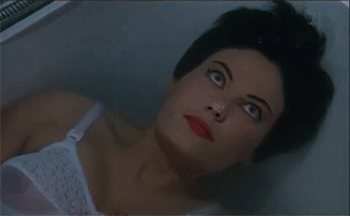 Since Blood and Black Lace wasn’t available through Netflix streaming, I put it in my queue. I found it was on Youtube in the meantime, but neglected to change the queue. So I watched the DVD with commentary by Tim Lucas turned on. Lucas starts his commentary like he starts the chapter on the film, with a quote by director Ernst Lubitsch: “Technicolor is interesting. It’s perfect for [Heaven Can Wait], wonderful for musicals and comedies. But… never shoot a drama or mystery in Technicolor.” Bava proved this wrong on a regular basis in the sixties, but this movie really drives the nail home. Note the use of bright red through the film. It’s in almost every scene. Those red mannequins make for an interesting bit of foreshadowing.
Since Blood and Black Lace wasn’t available through Netflix streaming, I put it in my queue. I found it was on Youtube in the meantime, but neglected to change the queue. So I watched the DVD with commentary by Tim Lucas turned on. Lucas starts his commentary like he starts the chapter on the film, with a quote by director Ernst Lubitsch: “Technicolor is interesting. It’s perfect for [Heaven Can Wait], wonderful for musicals and comedies. But… never shoot a drama or mystery in Technicolor.” Bava proved this wrong on a regular basis in the sixties, but this movie really drives the nail home. Note the use of bright red through the film. It’s in almost every scene. Those red mannequins make for an interesting bit of foreshadowing.
 Lucas calls this Bava’s first true giallo, and with its Italian title, Sei donne per l’assassino (Six Women for the Murderer), the first body count movie. Like most of Bava’s work, it had multiple titles in different languages: Blutige Seide (Bloody Silk) in German, and according to Lucas, a Danish title that translates as The Iron Hand in the Night of Horror, in reference to the death claw used in one scene. I especially like the over-the-topness of the pre-release title, The Fashion House of Death.
Lucas calls this Bava’s first true giallo, and with its Italian title, Sei donne per l’assassino (Six Women for the Murderer), the first body count movie. Like most of Bava’s work, it had multiple titles in different languages: Blutige Seide (Bloody Silk) in German, and according to Lucas, a Danish title that translates as The Iron Hand in the Night of Horror, in reference to the death claw used in one scene. I especially like the over-the-topness of the pre-release title, The Fashion House of Death.
 There’s a nice tracking shot through the fashion house early on. Lucas says Bava couldn’t afford a camera dolly on his budgets, so he mounted his camera on a child’s wagon.
There’s a nice tracking shot through the fashion house early on. Lucas says Bava couldn’t afford a camera dolly on his budgets, so he mounted his camera on a child’s wagon.
Bava knew that the real money was in the English language markets, so he had the actors memorize their lines in English even if they didn’t understand it. All his films were overdubbed anyway, due to noise on the set, but this way makes for a better illusion. Apparently his scriptwriter didn’t understand English all that well either, so American actress Mary Arden (victim number 3) rewrote a lot of the dialogue during the filming. Most of the male voices were performed by Paul Frees (Burgermeister Meisterburger, Boris Badenov).
While looking through Youtube, I found Eurotika – Blood and Black Lace: A Short History of the Italian Horror Film, which has this nice quote from actor Michel Lemoine:
Bava taught me that “the essence of cinema is framing. Framing is how you experience life. It’s that thing you see that attracts you to someone, a fault or a special quality, a look in someone’s eye, a certain decor that inspires you. It’s framing that creates emotion.”
Blood and Black Lace was released largely uncut in the US. Instead of working with AIP, who had hacked some of his earlier movies, Bava went with Allied Artists, who came up with the English title. The only significant change they made was the opening credits, which is kind of baffling because Bava’s are brilliant. But the distributors thought they weren’t scary enough, so they had an animated sequenced done as a replacement. One shot that did get cut in many countries was tail end of the bathtub murder. That bloom of blood was too much for some censors.



Pingback: bavatuesdays Episode 4: Blood and Black Lace | bavatuesdays
Pingback: All’s well that ends well | raptnrent.me